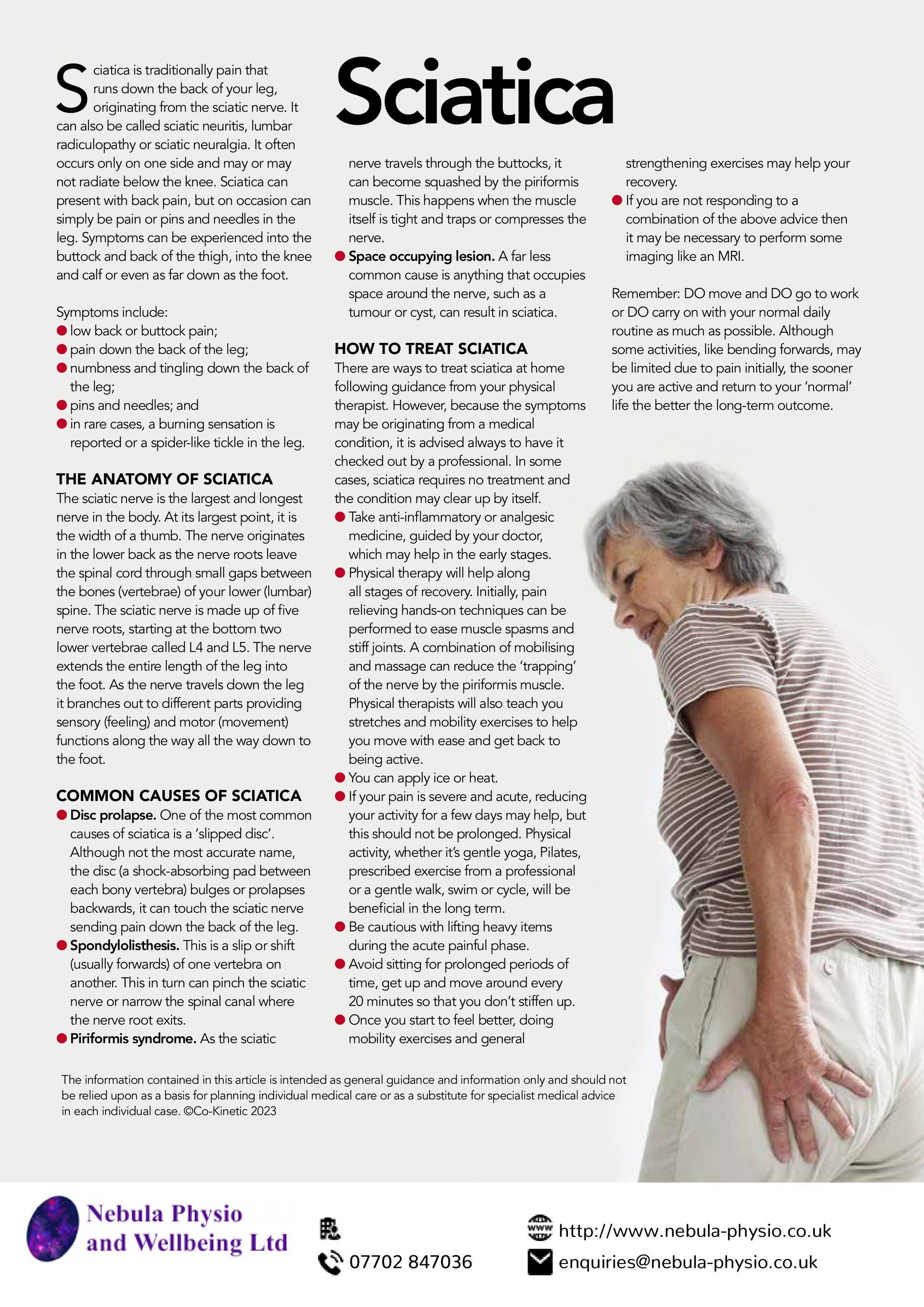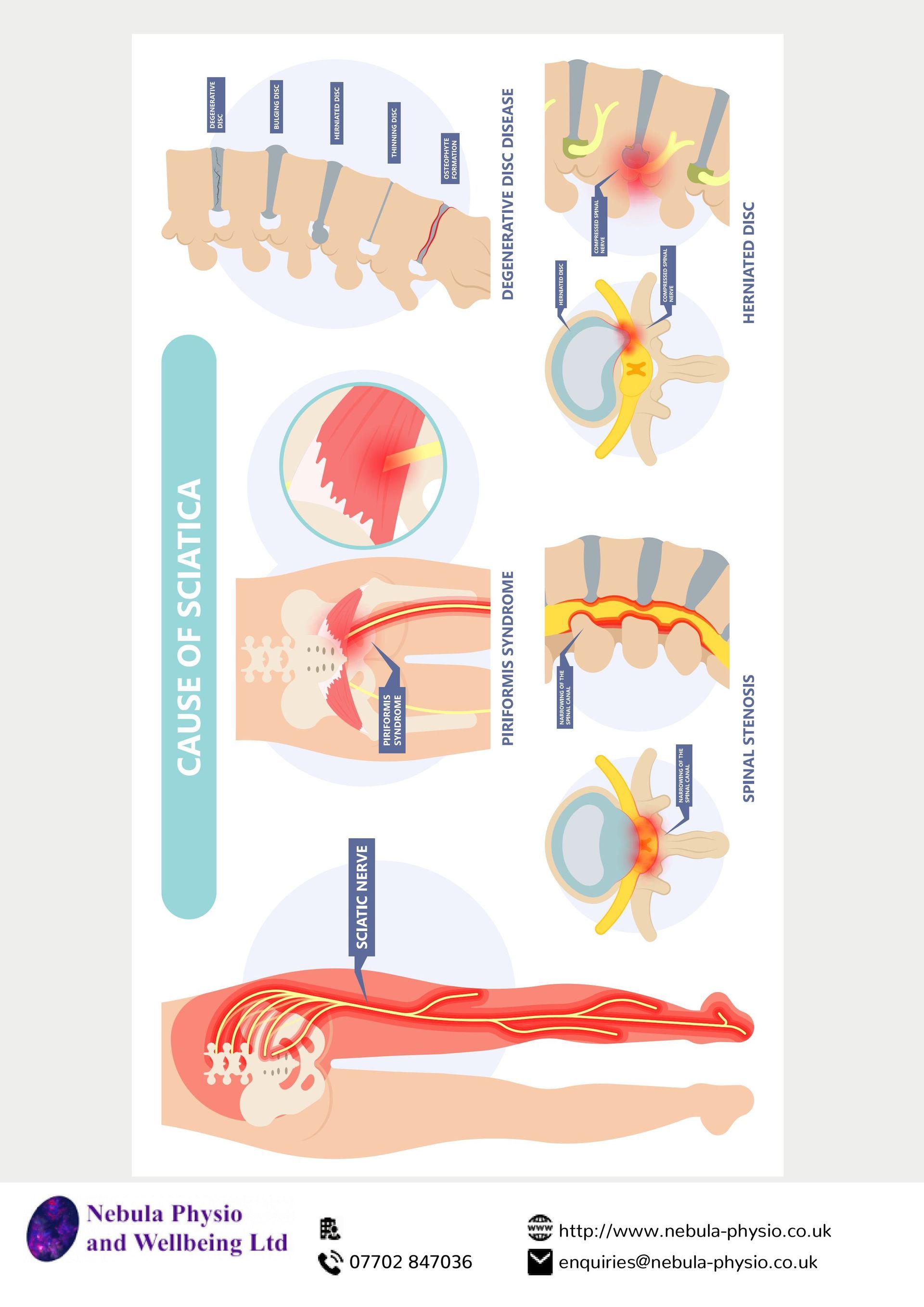Sciatica
Sciatica is a common condition that is often misunderstood and misdiagnosed. It is characterised by a pain, discomfort or pins and needles that originates from the sciatic nerve, which is the largest/thickest nerve in your body. This nerve is formed by smaller nerves known as nerve roots that enter and exit the spine in the lower back. Irritation of these nerve roots can cause pain to travel from your back into the buttock and thigh, or even down as far as your calf and foot. Symptoms are often single-sided.
It is important to note these symptoms may be caused from other similar conditions originating in the lower back region. As many as 40% of people will experience sciatica at some point in their lives, with the likelihood increasing as we age.
What are the signs?
If you are feeling a combination of lower back pain, numbness, tingling sensations, or muscle weakness (as some signals in the nerve can be blocked) that seems to travel from your lower back and down the back of your leg or into your foot, you might be dealing with sciatica. More unusual symptoms include a sensation of coldness and running water which occur because irritated nerves send more signals.
The pain from sciatica can vary dramatically – from a mild ache to an intense, sharp pain that almost feels like an electric shock. It is most noticeable when sitting or bending, and sometimes even simple actions like sneezing or coughing can intensify the discomfort.
What causes sciatica?
Anything that irritates a nerve root can cause sciatica. A common cause of irritation is compression from disc-related changes. Discs are tough circular structures that separate the bones of the spine. They attach strongly to the bones meaning they cannot ‘slip’, however they can develop ‘bulges’ which may compress or irritate nerve roots.
The good news is that nerve roots are resilient, they nearly always have wiggle room, and some disc related changes shrink over time allowing nerve roots to recover. In some cases, nerve roots are irritated by inflammation without any compression, which can be just as painful. Importantly, not all disc related changes will compress or irritate nerve roots. Many people of all ages have disc related changes without experiencing any pain.
The sciatic nerve can also be ‘squeezed’ or ‘trapped’ by a tight buttock muscle called Piriformis. In addition, sciatic pain can be influenced by general factors such as reduced sleep, stress and emotional wellbeing.
So how do we treat sciatica?
Fortunately, sciatica often improves without the need for surgery. Simple home remedies can be quite effective. For instance, alternating between cold and heat therapy can significantly ease the pain. Ice packs reduce inflammation, while heat treatments after the first week can soothe and relax your muscles.
Gentle exercises and stretches can also help with your mobility and pain management. Not only do they enhance flexibility, but they also activate and strengthen the muscles supporting your spine, offering relief and prevention from future episodes. Check out our blog "3 Simple Strategies to Improve Persistent Low Back Pain" for some gentle back-related exercises.
Activities such as walking, swimming, and cycling are great for your heart and appropriate for your sciatica when done gently. Strengthening your core, which includes your back, sides, pelvis, and buttocks, is also crucial for spinal support.
Posture Matters: Remember your mum’s advice about not slouching? She was right! Paying attention to your posture can make a big difference. And remember your posture when lifting heavy items!
Keeping a check on your weight also helps to reduce the risk of sciatica, as excess weight can put extra pressure on your spine.
Finally, ‘Break the Sitting Cycle’: If your job involves prolonged sitting, take regular breaks every 20-30 mins, or consider a standing desk. Have a look at our blogs on "3 Quick and Simple Movements to Do at Work" and "Optimal Desk Posture" for further information on movement during work and optimal workstation set-up.
Check out the leaflet below for further information on sciatica.
Key Message:
Sciatica is a common condition that generally improves without the need for surgery. Heat/ice, gentle exercises/stretches, general mobility, and posture can all improve symptoms. In short, try to keep moving and going about your daily business as best you can. Physiotherapy can also significantly improve symptoms, focussing on pain relief and mobility at first before progressing onto muscle strengthening.
If you would like further advice on how to manage or improve your sciatica or back pain, or you’d like help developing a bespoke exercise program to improve your muscle strength/coordination, give us a call on 07702 847036
and speak directly to a Senior Chartered Physiotherapist or click the ‘Book Online’ button to make an appointment. Both in-clinic and virtual video appointments are available.
The Nebula Physio and Wellbeing Team







